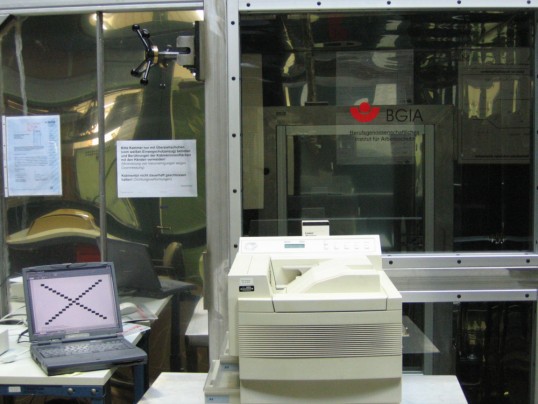- Elektromagnetic Fields
- Indoor workplaces
- Practical Solutions: Ergonomics
- Practical solutions: Hazardous substances
- Practical solutions: Noise
- Practical solutions: Machine safety
- Practical solutions: Personal Protective Equipment
Laser printers and copiers

Examination of a printer
Source: IFA
Office equipment with printing function such as laser printers and copiers have become an indispensable part of modern office life, used by millions of people every day. However, reports of potential health hazards due to laser printers purportedly causing exposure to toner dust have provoked public concern on more than one occasion. Various studies show, however, that laser printers and copiers do not emit significant amounts of dust or gas.
In the interests of environmental and user protection, the "Environmental Label Jury" has developed award criteria, referred to as RAL-UZ 171, for office equipment that has a print function (printers, copiers and multifunctional devices (MFDs)). As well as general requirements, e.g. recyclability and power consumption, and toner substance requirements, a major part of the awarding process involves emission testing. Chamber tests are carried out to determine the quantities of dust, ultrafine particles (UFPs), ozone, TVOCs, benzene and styrene emitted. The emissions are assessed on the basis of the current guideline values for environmental or indoor emissions, which are far lower than the applicable occupational exposure limits (OELs).
Generally speaking, the equipment is only tested in combination with the toner and paper sold for the specific device in question. In practice, however, the toner used often comes from a different manufacturer or in a recycled toner cartridge and has not been tested in conjunction with the device. The IFA has developed the GS-IFA-G03 test principles as quality and comparative criteria for toner. These principles place strict requirements upon the substances contained within toners, such as metals and volatile organic compounds, and upon the particle sizes. The DGUV test mark with supplementary indication that the toner powder has passed the test for hazardous substances may be applied to toner that is shown to satisfy the test criteria.
Paper is a source of emissions too. Due to the design parameters for laser printers, the paper is briefly heated to roughly 150 to 200 °C, which can cause it to give off certain substances. The award criteria for the Blue Angel RAL-UZ 14 eco-label for recycled paper, which include numerous environmental aspects, also consider potential emissions of volatile organic compounds if the paper is of a type intended to be used with electrophotographic printers or copiers (known as copying paper).
Research projects:
- FF-FP0294A "Investigation on health effects of emissions from laserprinters and -copiers, Subproject LMU: Exposition of volunteers in a climatic chamber"
- FF-FP0294B"Investigation on health effects of emissions from laserprinters and -copiers, Subproject BAM: Characterization of the emissions in a climatic chamber"
- IFA3133 "Emissions from ink-jet printers with printing speeds higher than 30 pages per minute"
For download

Report "Indoor workplaces"
Further information

Contact
Hazardous substances: handling, protective measures
Tel: +49 30 13001 3340Fax: +49 30 13001 38001